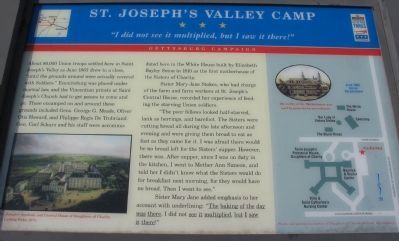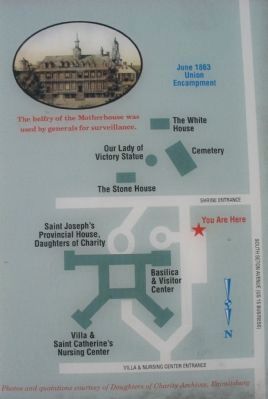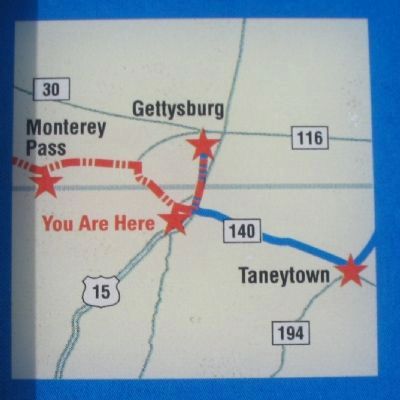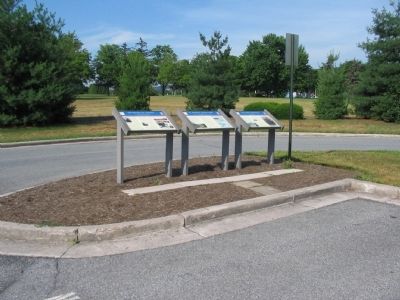Emmitsburg in Frederick County, Maryland — The American Northeast (Mid-Atlantic)
St. Joseph's Valley Camp
"I did not see it multiplied, but saw it there!"
— Gettysburg Campaign —
Sister Mary Jane Stokes, who had charge of the farm and farm workers at St. Joseph's Central House, recorded her experience of feeding the starving Union soldiers.
"The poor fellows looked half-starved, lank as herrings, and barefoot. The Sisters were cutting bread all during the late afternoon and evening and were giving them bread to eat as fast as they came for it. It was afraid there would be no bread left for the Sisters' supper. However there was. After supper, since I was on duty in the kitchen, I went to Mother Ann Simeon, and told her I didn't know what the Sisters would do for breakfast next morning, for they would have no bread. Then I went to see."
Sister Mary Jane added emphasis to her account with underlining: "The baking of the day was there. I did not see it multiplied, but I saw it was there!"
Erected by Maryland Civil War Trails.
Topics and series. This historical marker is listed in this topic list: War, US Civil. In addition, it is included in the Maryland Civil War Trails series list. A significant historical month for this entry is June 1863.
Location. Marker has been reported permanently removed. It was located near 39° 41.934′ N, 77° 19.645′ W. Marker was in Emmitsburg, Maryland, in Frederick County. Marker could be reached from South Seton Avenue (Business U.S. 15), on the right when traveling north. Located in the parking lot for the National Shrine of St. Elizabeth Ann Seton. Touch for map. Marker was at or near this postal address: 333 South Seton Avenue, Emmitsburg MD 21727, United States of America.
We have been informed that this sign or monument is no longer there and will not be replaced. This page is an archival view of what was.
Other nearby markers. At least 8 other markers are within walking distance of this location. A different marker also named St. Joseph's Valley Camp (here, next to this marker); Daughters of Charity (a few steps from this marker); Gen. John F. Reynolds (a few steps from this marker); The First Statue of Mother Seton Erected in the United States (within shouting distance of this marker); The Stone House (about 600 feet away, measured in a direct line); The Bells of St. Joseph's Valley (about 700 feet away); Sisters of Charity of Saint Vincent de Paul of New York (about 700 feet away); Saint Elizabeth Ann Seton (1774-1821) (about 700 feet away). Touch for a list and map of all markers in Emmitsburg.
More about this marker. In the lower left is a painting of St. Joseph's Academy and Central House of Daughters of Charity by Ludwig Enke, 1873. On the right is a map of the grounds indicating noteworthy buildings and sites. Within the map is a drawing captioned The belfry of the Motherhouse was used by generals for surveillance. In the upper left is a small map indicating Civil War trails sites in the nearby area.
Related marker. Click here for another marker that is related to this marker. This marker has been replaced by the linked marker.
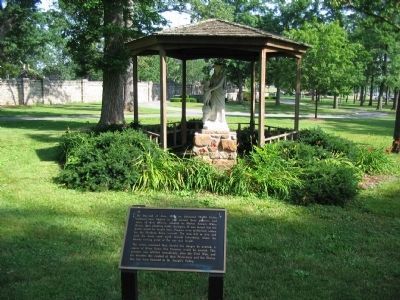
Photographed By Craig Swain, June 22, 2008
5. Our Lady of Victory Statue
The plaque reads:
By the end of June, 1863 an estimated 90,000 Union soldiers were located in and around these premises and some of their officers, situated in Mother Seton's White House, were planning battle strategies. It was feared that the battle would be fought here. Prayers were multiplied; orders for the Northern Army arrived. The men fell in line and took the dusty road north toward Gettysburg, where the bloody turning point of the war was fought.
The sisters promised that, should this danger be averted, a statue of Notre Dame Des Victoires would be erected. This promise was fulfilled immediately after the Civil War, and for decades this symbol of their Protectress and her Divine Son has been honored in St. Joseph's Valley.
By the end of June, 1863 an estimated 90,000 Union soldiers were located in and around these premises and some of their officers, situated in Mother Seton's White House, were planning battle strategies. It was feared that the battle would be fought here. Prayers were multiplied; orders for the Northern Army arrived. The men fell in line and took the dusty road north toward Gettysburg, where the bloody turning point of the war was fought.
The sisters promised that, should this danger be averted, a statue of Notre Dame Des Victoires would be erected. This promise was fulfilled immediately after the Civil War, and for decades this symbol of their Protectress and her Divine Son has been honored in St. Joseph's Valley.
Credits. This page was last revised on March 27, 2020. It was originally submitted on July 23, 2008, by Craig Swain of Leesburg, Virginia. This page has been viewed 1,702 times since then and 25 times this year. Photos: 1, 2, 3, 4, 5. submitted on July 23, 2008, by Craig Swain of Leesburg, Virginia.
